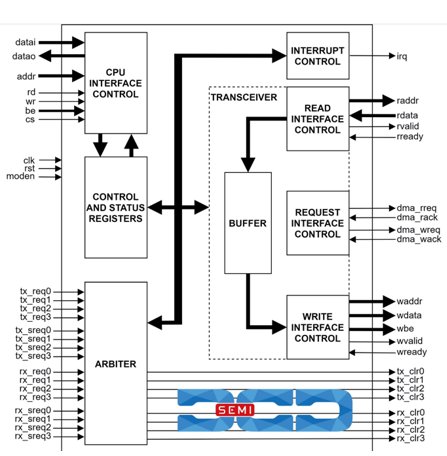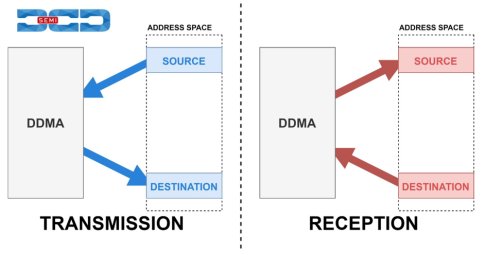DDMA, multi-channel DMA Controller IP core from DCD-SEMI
Bytom, Poland -- December 15, 2022 -- The DDMA is a four-channel Direct Memory Access Controller, with purpose to transfer data between memories and peripherals – to significantly reduce CPU utilization during data transfers. It can be programmed by any CPU via a 32-bit or 8-bit native interface.
The DDMA can perform data transactions of configurable size over 32-bit address space. A single transaction size can be set in a range from 1B to 16MB. To limit the negative impact of different reads and writes timing the DDMA features transfer data buffer. This buffer is a 32-bit FIFO memory with configurable depth.

Data transactions can be triggered either by hardware or software. Hardware initialization is achieved via the Peripheral Request Interface, while software initialization is done by the CPU via registers. The Peripheral Request Interface is used by external controllers (peripherals) to set data transaction request on specific DDMA channel. Each of the DDMA channels has a set of Peripheral Request Interface signals associated with it. Peripherals can request the transmission or reception of data. When multiple channels await data transfer the arbitration process utilizes a round-robin algorithm.
DCD-SEMI’s IP Core includes four DDMA channels. Each has its configuration registers and enable bit. The DDMA offers three transfer modes:
- SINGLE - single data transfer on request,
- NORMAL - one data block transfer on request,
- BLOCK - all data blocks transfer on request.
They are distinguished by the amount of data transferred on a single request. Data transaction is divided into blocks. It is possible to configure the number of block bytes and number of blocks in a transaction. Data transfer is performed between the data source and the data destination. The DDMA channel can perform reads and writes on 32-bit, 16-bit, and 8-bit data which is separately configurable for both source and destination. Source and destination addresses can be freely configured.

The DDMA offers three addressing modes:
- INC – increment address after each data access,
- DEC – decrement address after each data access,
- FIXED – the address is fixed.
Apart from the above, the IP Core has three sources and destination address reload options:
- TRANSACTION – address is reloaded after the full transaction,
- BLOCK – the address is reloaded with each block transferred,
- NEVER – the address is never reloaded.
Address, block, and byte registers are double buffered so that if they are changed while the channel is busy, the change does not take effect until the current data transfer is over.
Each channel has status and transfers status flags. Channel status is defined as BUSY, PENDING, or IDLE. Transfer status flags inform about the amount of data that has been sent by the channel. Proper flags are set after the transmission of single data, block, or transaction. Each transfer status flag is masked which allows for generating an interrupt request when a specific data transfer situation occurs.

Key features :
- 32-bit or 8-bit internal registers access
- 32-bit transmission address range
- Transaction size from 1B up to 16MB
- Four transmission channels
- Round robin arbitration
- Data buffer with configurable size
- For each channel:
- Enable bit
- Software transmission request
- Peripheral request interface:
- Transmission request
- Single data transmission request
- Reception request
- Single data reception request
- Configurable request clear signal
- Transfer status flags:
- Transaction finished
- Block finished
- Single data finished
- Transfer status flags maskable interrupts
- Three transfer modes:
- SINGLE
- NORMAL
- BLOCK
- Independently configurable source and destination data width:
- 32-bits
- 16-bits
- 8-bits
- Configurable source and destination base addresses
- Three addressing modes: INC, DEC, FIXED
- Three source and destination address reload options each:
- TRANSACTION
- BLOCK
- NEVER
- Transaction divided into blocks
- Configurable transfer size: including amount of blocks and blocks size
- Double buffered address, block and byte registers
- Available DMA interface wrappers:
- Native 32-bit interface
- AMBA – APB / AHB / AXI Lite
- Software reset
- Configurable hardware reset
- Fully synthesizable
- No internal tri-states
Related Semiconductor IP
- DMA Controller
- DMA Controller
- Multi-Channel Streaming DMA Controller
- AHB/AXI/Wishbone DMA Controller
- ULL PCIe DMA Controller
Related News
- Digital Blocks AMBA Multi-Channel DMA Controller IP Core Family Extends Leadership with releases for core DMA Engines in RISC-V® & ARM® Systems and Peripherals to Memory Applications
- CAST Launches Multi-Channel DMA IP Core Ideal for Streaming Applications
- DCD-SEMI Brings Full ASIL-D Functional Safety to Entire Automotive IP Cores Portfolio
- DCD-SEMI Unveils Ultra-Fast DAES IP Core for AES Encryption
Latest News
- M5ERS Joins Arm Flexible Access Program to Accelerate Development of Ultra-Low-Power APU Products
- The 2025 deals reshaping the semiconductor industry
- Weebit Nano reports on 2025 targets achievement
- GUC Monthly Sales Report – December 2025
- Chips&Media and Visionary.ai Unveil the World’s First AI-Based Full Image Signal Processor, Redefining the Future of Image Quality